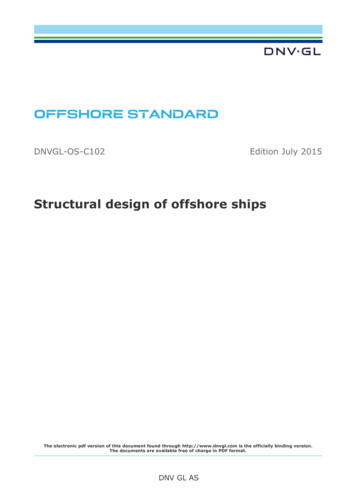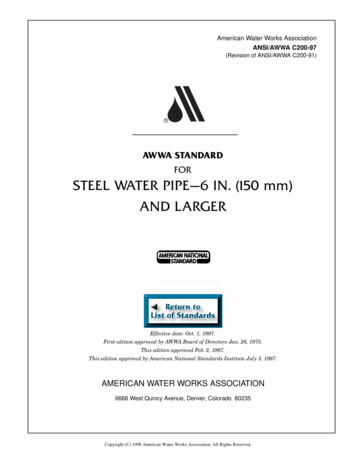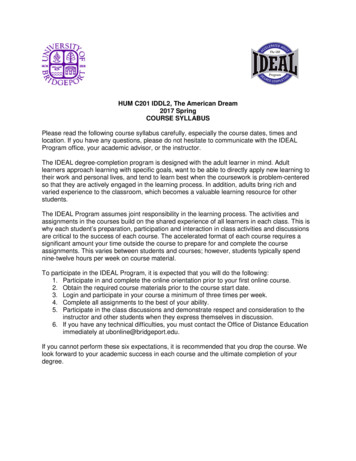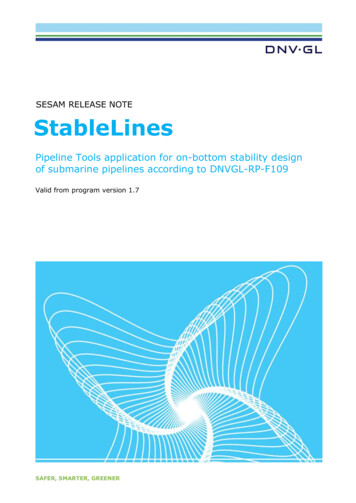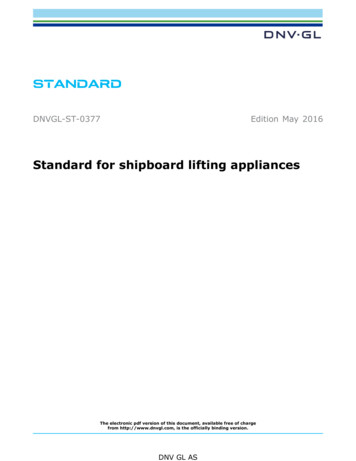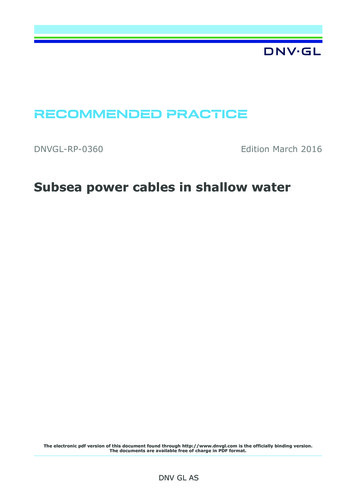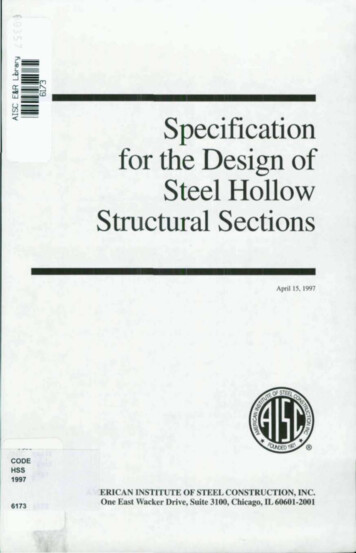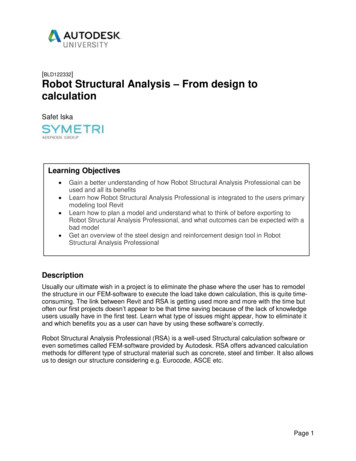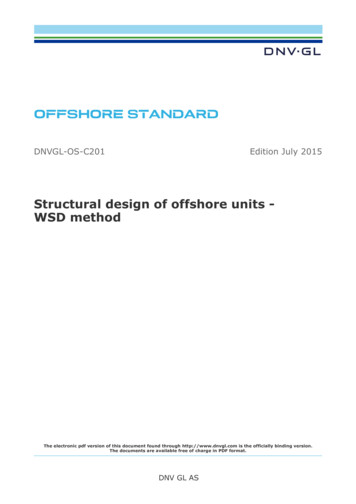
Transcription
OFFSHORE STANDARDDNVGL-OS-C201Edition July 2015Structural design of offshore units WSD methodThe electronic pdf version of this document found through http://www.dnvgl.com is the officially binding version.The documents are available free of charge in PDF format.DNV GL AS
FOREWORDDNV GL offshore standards contain technical requirements, principles and acceptance criteria related toclassification of offshore units. DNV GL AS July 2015Any comments may be sent by e-mail to rules@dnvgl.comThis service document has been prepared based on available knowledge, technology and/or information at the time of issuance of this document. The use of thisdocument by others than DNV GL is at the user's sole risk. DNV GL does not accept any liability or responsibility for loss or damages resulting from any use ofthis document.
GeneralThis document supersedes DNV-OS-C201, October 2014.Text affected by the main changes in this edition is highlighted in red colour. However, if the changesinvolve a whole chapter, section or sub-section, normally only the title will be in red colour.On 12 September 2013, DNV and GL merged to form DNV GL Group. On 25 November 2013 Det NorskeVeritas AS became the 100% shareholder of Germanischer Lloyd SE, the parent company of the GL Group,and on 27 November 2013 Det Norske Veritas AS, company registration number 945 748 931, changed itsname to DNV GL AS. For further information, see www.dnvgl.com. Any reference in this document to “DetNorske Veritas AS”, “Det Norske Veritas”, “DNV”, “GL”, “Germanischer Lloyd SE”, “GL Group” or any otherlegal entity name or trading name presently owned by the DNV GL Group shall therefore also be considereda reference to “DNV GL AS”.Main changes July 2015 General— The document has been updated to reflect and align with all updates in DNV-OS-C105, Structural Designof Tension Leg Platforms (LRFD method). — Ch.2 Sec.6 FatigueAcceptance criteria for scantling check under overflow tank pressure have been revised.Ch.2 Sec.12 Special considerations for tension leg platforms (TLP)— [1.1.1]: A reference to API-RP-2T has been added.— [1.2.4]: Functional requirements for tendons have been updated— [2.2] A clearer definition of structural categories has been provided.— [2.3.5]: Special considerations have been added for casting material.— [2.4]: Design temperature definition to be aligned with other OS has been updated.— [3.2.1]: Better definition of class scope with respect to temporary phases has been provided.— [3.4]: Considerations/guidance notes for tendon fabrication have been added.— [3.7]: Considerations have been added for VIV/VIM and tendon buckling during tendon free standingphase.— [3.9]: Removal of previous clause [3.8.9] on settlement or subsidence.— [3.9.2]: Better definition of tendon design principal, Guidance note has been added to explain 'fail proof'philosophy.— [3.10]: Design principles for foundation have been added.— [3.11]: Design principles for systems have been added - special consideration for TLP application.— [3.12]: Design principles for simultaneous operations have been added.— [4.2.2]: Guidance note has been added with regards to minimum sea pressure.— [4.2.11]: Acceptance criteria for scantling check under overflow tank pressure have been revised.— [5.1.2]: Definition of design conditions to be considered has been clarified.— [6.1.4]: New clause referring to DNVGL-OS-C301 has been added.— [6.1.9]: Guidance note has been added with regards to inclining test requirement for TLP.— [6.2.1]: Guidance note has been added with regards to design wave selection for TLP.— [6.5.2]: A new clause on deck vibration has been added.— [6.5.3]: Airgap requirement has been updated to be in line with DNVGL-OS-C105.— [6.6]: Reference has been added for requirements with respect to scantling and weld connections.— [6.7.7]: Acceptance criteria for temporary loss in tendon tension has been added to be in line with OSC105.Offshore standard, DNVGL-OS-C201 – Edition July 2015Structural design of offshore units - WSD methodDNV GL ASPage 3Changes – currentCHANGES – CURRENT
— [7.3.10]: Requirements and guidance note on maximum allowable flaw size and NDT method have beenupdated to be in line with DNVGL-OS-C105.— [7.4]: Requirement with regards to pile fatigue damage due to pile driving has been added.— [8.1.7]: Guidance note has been added with regards to ballast system capacity.— [8.2]: A clearer definition has been provided with respect to accidental loads required in the design.— [8.3.3]: Requirement of analysis to evaluate consequence of tendon failure has been deleted.— [8.3.4]: Requirements for tendon tension in accidental condition has been added to be in line with OSC105. Ch.3 Sec.2 Certification of tendon system— [1.1.3]: List of acceptable standards has been deleted and reference is made to Tables 1-1 and 1-2.— [4]: Definition of IRN has been deleted because this is no longer issued; certification for subcomponents has been clarified.— [5]: Previous sub-section [5.5] on Foundation has been deleted; relevant requirements have beenmoved to relevant sections in Ch.2.— [5.2]: Further completed with regard to welding requirements and acceptance criteria. Guidance notehas been updated to clarify requirements for line pipes.— [5.7]: Some requirements for tendon tension monitoring system (TTMS) that were accidentally deletedhave been reinstated.— [5.8]: Acceptance criteria for tendon porch have been added.— [5.10]: Requirements for load management program (LMP) have been further clarified.— [6]: Categorization of tendon components, sub-components and their certificate requirements has beenclarified.— [7.1.2]: Guidance note has been added with regards to level of NDT for tendon pipes.Editorial correctionsIn addition to the above stated main changes, editorial corrections may have been made.Offshore standard, DNVGL-OS-C201 – Edition July 2015Structural design of offshore units - WSD methodDNV GL ASPage 4Changes – current— [6.9]: Foundation design section has been updated with more detailed requirements.— [7.3.7]: Guidance note on fracture toughness has been updated to be in line with DNVGL-OS-C105.
CHANGES – CURRENT . 3CH. 1 INTRODUCTION . 15Sec.1Introduction . 151General .151.1 Introduction. 151.2 Objectives . 151.3 Scope and application . 151.4 Other than DNV GL codes . 162References.162.1 General . 163Definitions .183.1 Verbal forms . 183.2 Terms . 184Abbreviations and symbols .224.1 Abbreviations . 224.2 Symbols . 23CH. 2 TECHNICAL PROVISIONS . 26Sec.1Sec.2Design principles. 261Introduction .261.1 General . 261.2 Aim of the design . 262General design considerations .262.1 General . 262.2 Overall design . 262.3 Details design . 273Design conditions .273.1 Basic conditions. 274Loading conditions.284.1 General . 284.2 Load . 285Design by the WSD method .285.1 Permissible stress and usage factors . 285.2 Basic usage factors . 296Design assisted by testing .296.1 General . 296.2 Full-scale testing and observation of performance ofexisting structures . 29Loads and load effects. 301Introduction .301.1 General . 302Basis for selection of loads .302.1 General . 303Permanent functional loads .313.1 General . 31Offshore standard, DNVGL-OS-C201 – Edition July 2015Structural design of offshore units - WSD methodDNV GL ASPage 5ContentsCONTENTS
Variable functional loads .314.1 General . 314.2 Variable functional loads on deck areas. 324.3 Tank pressures. 325Environmental loads .335.1 General . 335.2 Environmental conditions for mobile units . 335.3 Environmental conditions for site specific units . 345.4 Determination of hydrodynamic loads. 345.5 Wave loads . 355.6 Wave induced inertia forces . 365.7 Current . 365.8 Wind loads. 365.9 Vortex induced oscillations . 365.10 Water level and tidal effects . 365.11 Marine growth . 375.12 Snow and ice accumulation . 375.13 Direct ice load . 375.14 Earthquake . 376Combination of environmental loads .386.1 General . 387Accidental loads.387.1 General . 388Deformation loads .398.1 General . 398.2 Temperature loads. 398.3 Settlements and subsidence of sea bed . 399Fatigue loads .399.1 General . 3910 Load10.110.210.3Sec.3effect analysis .40General . 40Global motion analysis . 40Load effects in structures and soil or foundation . 40Structural categorisation, material selection and inspection principles . 421General .422Temperatures for selection of material .422.1 General . 422.2 Floating units . 422.3 Bottom fixed units . 423Structural category .423.1 General . 423.2 Selection of structural category . 433.3 Inspection of welds . 434Structural steel .444.1 General . 444.2 Material designations . 454.3 Selection of structural steel. 464.4 Fracture mechanics (FM) testing . 474.5 Post weld heat treatment (PWHT) . 47Offshore standard, DNVGL-OS-C201 – Edition July 2015Structural design of offshore units - WSD methodDNV GL ASPage 6Contents4
Sec.5Sec.6Structural strength. 481General .481.1 General . 481.2 Structural analysis . 481.3 Ductility . 481.4 Yield check . 491.5 Buckling check . 492Flat Plated structures and stiffened panels.502.1 Yield check . 502.2 Buckling check . 502.3 Capacity checks according to other codes . 503Shell structures .503.1 General . 504Tubular members, tubular joints and conical transitions .514.1 General . 515Non-tubular beams, columns and frames.515.1 General . 51Section scantlings . 521Scope.522Strength of plating and stiffeners .522.1 Scope . 522.2 Minimum thickness . 522.3 Bending of plating . 522.4 Stiffeners . 533Bending and shear in girders .543.1 General . 543.2 Minimum thickness . 543.3 Bending and shear . 543.4 Effective flange . 543.5 Effective web . 553.6 Strength requirements for simple girders . 553.7 Complex girder systems . 56Fatigue . 571Sec.7General .571.1 General . 571.2 Design fatigue factors . 571.3 Methods for fatigue analysis. 581.4 Simplified fatigue analysis. 581.5 Stochastic fatigue analysis . 59Accidental conditions . 601General .601.1 General . 602Design criteria .602.1 General . 602.2 Collision . 612.3 Dropped objects . 612.4 Fires . 612.5 Explosions . 612.6 Unintended flooding . 61Offshore standard, DNVGL-OS-C201 – Edition July 2015Structural design of offshore units - WSD methodDNV GL ASPage 7ContentsSec.4
Weld connections . 631Scope.632Types of welded steel joints .632.1 Butt joints . 632.2 Tee or cross joints . 632.3 Slot welds. 652.4 Lap joint. 653Weld3.13.23.33.43.53.6Sec.9size .65General . 65Fillet welds . 66Partly penetration welds and fillet welds in cross connectionssubject to high stresses . 67Connections of stiffeners to girders and bulkheads, etc. . 67End connections of girders . 69Direct calculation of weld connections. 69Corrosion control . 711Introduction .711.1 General . 711.2 Scope . 712Techniques for corrosion control related to environmental zones.712.1 Atmospheric zone . 712.2 Splash zone . 712.3 Submerged zone . 722.4 Internal zone . 723Cathodic protection .733.1 General . 733.2 Galvanic anode systems . 743.3 Impressed current systems . 744Coating systems .754.1 Specification of coating. 75Sec.10 Special considerations for column stabilised units . 771General .771.1 Assumptions and application . 772Structural categorisation, material selection andinspection principles.772.1 General . 772.2 Structural categorisation. 772.3 Material selection. 782.4 Inspection categories . 783Design and loading conditions .813.1 General . 813.2 Permanent loads . 813.3 Variable functional loads. 813.4 Tank loads. 823.5 Environmental loads, general . 823.6 Sea pressures . 823.7 Wind loads. 833.8 Heavy components . 833.9 Combination of loads. 834Structural strength .844.1 General . 84Offshore standard, DNVGL-OS-C201 – Edition July 2015Structural design of offshore units - WSD methodDNV GL ASPage 8ContentsSec.8
Global capacity. 84Transit condition. 84Method of analysis . 84Air gap . 855Fatigue .865.1 General . 865.2 Fatigue analysis . 866Accidental conditions.866.1 General . 866.2 Collision . 876.3 Dropped objects . 876.4 Fire. 876.5 Explosion. 876.6 Heeled condition. 877Redundancy .887.1 General . 887.2 Brace arrangements. 888Structural strength in way of a fixed mooring system .889Structural details .889.1 General . 889.2 Critical connections . 88Sec.11 Special considerations forself-elevating units . 891Introduction .891.1 Scope and application . 892Structural categorisation, material selectionand inspection principles .892.1 General . 892.2 Structural categorisation. 892.3 Material selection. 902.4 Inspection categories . 903Design and loading conditions .903.1 General . 903.2 Transit . 913.3 Installation and retrieval. 923.4 Operation and survival . 934Environmental conditions .
Offshore standard, DNVGL-OS-C201 – Edition July 2015 Page 4 Structural design of offshore units - WSD method DNV GL AS —— [6.9][7.3.7
